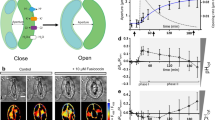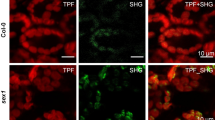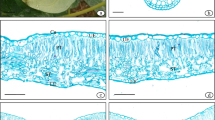Abstract
THE mechanism of the movement of stomatal guard cells in response to the stimulus of light, although under investigation for nearly a century, is still in doubt. The classical view1 that such movements are due to changes of turgor has received support from many workers, who have found by plasmolytic methods that with stomatal opening the osmotic pressure in the guard cells increases2-6. More recently, the possible collaboration of a 'wall mechanism' in opening the stomata of Cyclamen and Tradescantia has been disproved7., so that a turgor mechanism alone must be concerned ; but how the changes in turgor are produced is still uncertain. Mainly owing to the work of Lloyd8, Hagen9, Loft-field10 and Sayre5 it is very generally accepted that they are due to hydrolysis or condensation of starch in the guard cells, probafily brought about by enzyme action governed by pH. changes in response to light. A careful examination of these and other relevant papers, however, shows that nearly all the evidence for such a mechanism is based on the observation of diurnal changes in starch content and stomatal aperture under natural conditions. These observations leave little doubt that, under such conditions, pore size and starch content are to a large extent, though by no means completely, negatively correlated. A similar inverse relation is shown where change of aperture is experimentally induced by altering the water relations of the leaf2, or by immersing detached pieces of leaf or epidermis in various solutions11-14; but such data are not necessarily relevant to the problem of a light response. Where stomatal movement has been experimentally induced by changes of lighting conditions, at other than the natural times, the evidence for a correlation between starch content and stomatal aperture is not convincing8,15. The correlation of diurnal trends is an unsafe basis for a causal theory, especially in this case, since it has been shown that in cherry laurel16 and Pelargonium17,18 there is a diurnal rhythm of stomatal movement even under conditions of constant illumination. The diurnal rhythm of stomatal starch, which has not been shown to be due to light, may well provide the motive power for such autonomous stomatal movements.
This is a preview of subscription content, access via your institution
Access options
Subscribe to this journal
Receive 51 print issues and online access
$199.00 per year
only $3.90 per issue
Buy this article
- Purchase on Springer Link
- Instant access to full article PDF
Prices may be subject to local taxes which are calculated during checkout
Similar content being viewed by others
References
Von Mohl, H., Bot. Z., 14, 697, 713 (1856).
Iljin, W. S., Beih. Bot. Zbl. 32, 15 (1914).
Wiggans, R. G., Amer. J. Bot., 8, 30 (1921).
Steinberger, A. L., Biol. Zbl., 42, 405 (1922).
Sayre, J. D., Ohio J. Sci., 26, 233 (1926).
Strugger, S., and Weber, F., Ber. deutsch bot. Ges., 44, 272 (1926).
Heath, O. V. S., New Phyt., 37, 385 (1938).
Lloyd, F. E., Pub. Carneg. Inst., 82 (1908).
Hagen, F., Beitr. allg. Bot., 1, 261 (1918).
Loftfield, J. V., Pub. Carneg. Inst., 314 (1921).
Arends, J., Planta, 1, 84 (1926).
Scarth, G. W., Plant Physiol., 7, 481 (1932).
Small, J., and Maxwell, K. M., Protoplasma, 32, 272 (1939).
Small, J., et al., Proc. Roy. Soc. Edin., B, 61, 233, 236, 247 and 254 (1942).
Rosing, M. S., Ber. deutsch bot. Ges., 26, 438 (1908).
Maskell, E. J., Proc. Roy. Soc., B, 102, 488 (1928).
Gregory, F. G., and Pearse, H. L., Proc. Roy. Soc., B, 114, 477 (1934).
Gregory, F. G., and Pearse, H. L., Ann. Bot., N.S. 1, 3 (1937).
Parkin, J. . Phil. Trans. Roy. Soc., B, 191, 35 (1899).
Author information
Authors and Affiliations
Rights and permissions
About this article
Cite this article
HEATH, O. ROLE OF STARCH IN LIGHT-INDUCED STOMATAL MOVEMENT, AND A NEW REAGENT FOR STAINING STOMATAL STARCH . Nature 159, 647–648 (1947). https://doi.org/10.1038/159647b0
Issue Date:
DOI: https://doi.org/10.1038/159647b0
This article is cited by
-
Stomatal movements depend on interactions between external night light cue and internal signals activated by rhythmic starch turnover and abscisic acid (ABA) levels at dawn and dusk
Acta Physiologiae Plantarum (2017)
-
Untersuchungen �ber Photosynthese und Atmung unter Nat�rlichen Bedingungen W�hrend des Winterhalbjahres bei Pinus Silvestris L., Picea Excelsa Link. und Juniperus Communis L.
Planta (1965)
-
Quantitative Estimation of Stomatal Starch
Nature (1950)
-
Control of Stomatal Movement by a Reduction in the Normal Carbon Dioxide Content of the Air
Nature (1948)
Comments
By submitting a comment you agree to abide by our Terms and Community Guidelines. If you find something abusive or that does not comply with our terms or guidelines please flag it as inappropriate.



